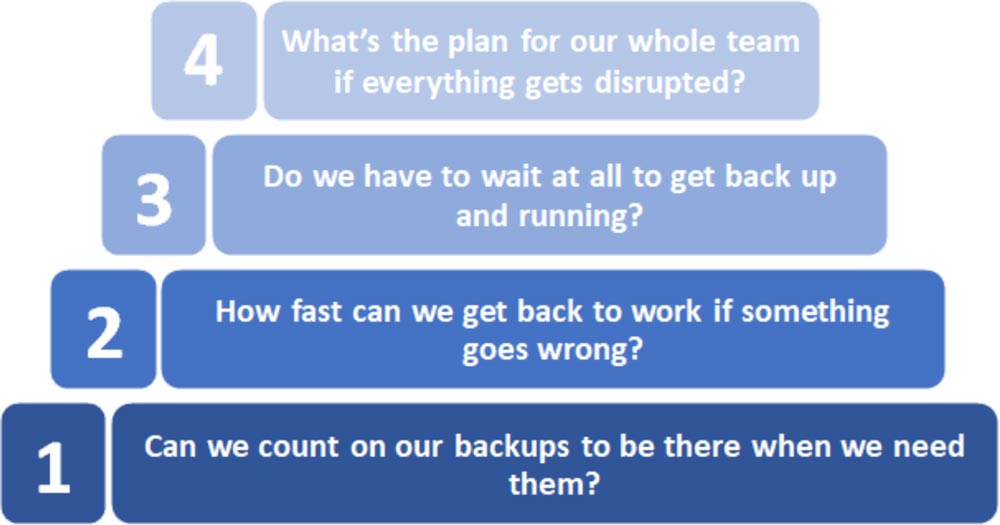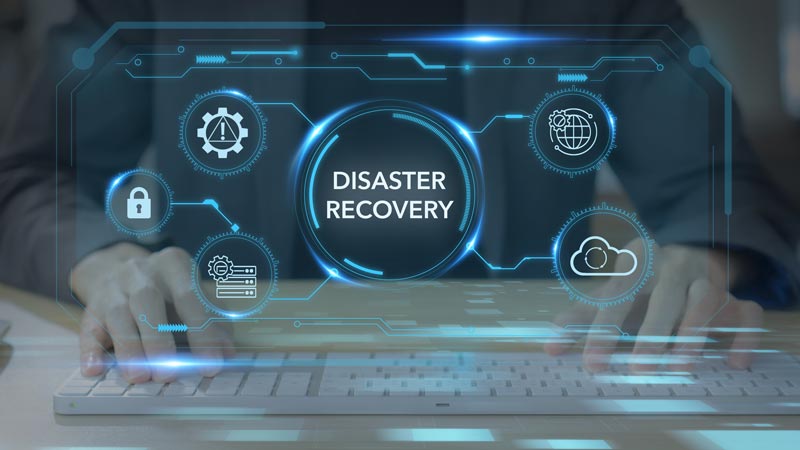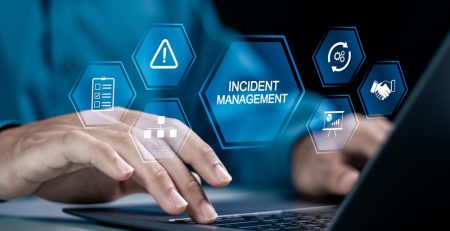Understanding the Levels of IT Preparedness
Unexpected disruptions can cripple your organization. Losing important data can be devastating.
Between natural disasters, cyberattacks, hardware failures and simple human error, there are several situations that your organization needs to be prepared for.
To safeguard your organization, it starts with answering these two key questions:
- Can we count on our backups to be there when we need them?
- How fast can we get back to work if something goes wrong?
Every organization needs a plan to manage risks, but the level of preparation depends on your industry, operations and how much downtime you can afford.
As your organization grows, these additional questions will come into focus:
- Do we have to wait to get back up and running?
- What’s the plan for our whole team if everything gets disrupted?
There are four key layers to protecting your organization’s data. The bigger you grow, the more critical these layers become — especially as more data and people depend on your IT.
We’ll discuss each layer, beginning with the essentials every organization should have and ending with advanced solutions that fit specific organizations.
Four Layers to Protect Your Data

Layer 1: Trusting Your Backups
Overview: For most small businesses, backups are affordable and easy to implement, often with daily or even hourly updates to minimize data loss.
Key question: Can we count on our backups to be there when we need them?
A backup is your organization’s safety net, ensuring you can recover data after a disaster like hardware failure, cyberattacks or human error.
However, there are bad backup solutions and good backup solutions. Consider these factors to determine if your backups are truly effective:
- Off-site storage: Are your backups protected from physical disasters like fires or floods? Keeping backups off-site or in the cloud ensures they remain safe even if your primary location is compromised.
- Ransomware resilience: Do you have at least one backup that is offline or stored in the cloud? This prevents ransomware from encrypting it, ensuring your data is accessible and out of reach from attackers.
- File-level recovery: Can you restore individual files without performing a full system recovery? This minimizes disruption when only a portion of your data is affected.
- Encryption: Are your backups encrypted to protect sensitive information from unauthorized access? Even if attackers steal your encrypted data, it’s unreadable, useless and can’t be used against you.
- Testing and review: How often do you test your backups to ensure they actually work? Regular reviews and tests are essential for catching errors.
Layer 2: Minimizing Downtime
Overview: Very small organizations may find that basic recovery solutions provide a sufficient safety net to meet their needs and choose to stop investing time and money after Layer 1. However, as organizations grow, the cost of downtime increases. At a certain point, it becomes necessary to invest in Layer 2 efforts to implement faster recovery methods and avoid the large costs of paying people to sit around while you restore your data.
Key Question: How fast can we get back to work if something goes wrong?
Once you’ve ensured your data is secure, the next challenge is restoring it quickly.
Recovery can take hours or even days depending on the size of your systems and the complexity of your workflows.
Organizations at this stage often implement tools and processes to :
- Local backups for speed: Solutions that store backups locally can restore systems faster than those that rely on cloud storage.
- Recovery planning: Testing how long it takes to restore from a backup helps set restoration expectations.
“Every organization should have reliable, tested backups to recover from basic disruptions. From there, you can add additional protections like faster recovery options, live redundancy and disaster plans based on your risk tolerance and operational needs.”
Layer 3: Seamless Continuity
Overview: Redundancy is a significant investment — essentially doubling your infrastructure costs — but it’s invaluable for industries like health care, finance or e-commerce, where uptime is critical.
Key Question: Do we have to wait to get back up and running?
For organizations that cannot afford even a few minutes of downtime, redundancy takes risk mitigation to the next level.
Instead of waiting to restore a backup, your operations can continue seamlessly on a live backup system.
- Redundant systems: Secondary systems run alongside your primary ones, ready to take over automatically in the event of a failure.
- Minimal data loss: With live redundancy, your operations might pause for a minute or two during a failure, but minimal recent data is lost.
Layer 4: Comprehensive Disaster Planning
Overview: A disaster recovery plan (DRP) is about aligning your entire organization — not just IT — around resilience. It’s the ultimate step in protecting your organization from the unexpected.
Key Question: What’s the plan for our whole team if everything gets disrupted?
At this stage, you’re looking beyond IT.
A (DRP) ensures your organization can keep running even in large-scale disasters, incorporating factors like:
- Communication plans: How will you notify staff, customers and vendors during a crisis?
- Alternate work locations: Where will your team operate if your office is inaccessible?
- Compliance: What legal and regulatory requirements must you meet during a disruption?
Takeaway: Start Where You Are, Build as You Grow
We understand IT preparedness is a daunting task that can feel overwhelming and costly.
Every organization should have reliable, tested backups to recover from basic disruptions. From there, you can add additional protections like faster recovery options, live redundancy and disaster plans based on your risk tolerance and operational needs.
If you’re unsure where to start — or whether your backups are as trustworthy as you think — contact us today. We’ll help you assess your risks and create a plan that gives you confidence without overspending on solutions you don’t need.
Stay updated! Get tips and insights delivered to your inbox weekly by subscribing to our newsletter.











